Strategic Management: Leadership Skills at Pearce Construction
VerifiedAdded on 2023/04/23
|21
|4696
|345
Report
AI Summary
This report evaluates the current management style at Pearce Construction, which is identified as autocratic under CEO Mr. Brain Pearce, leading to decreased market share and profit margins. The report reviews relevant leadership theories such as Huneryager and Heckman's leadership models, Likert's 4s leadership style, and McGregor's Theory X and Theory Y to highlight the drawbacks of the current approach. It suggests alternative leadership styles, including transformational leadership, to inspire employees and foster growth. The report emphasizes the need for a shift in leadership to address declining revenue and improve employee motivation and loyalty. Desklib provides access to similar solved assignments and resources for students.
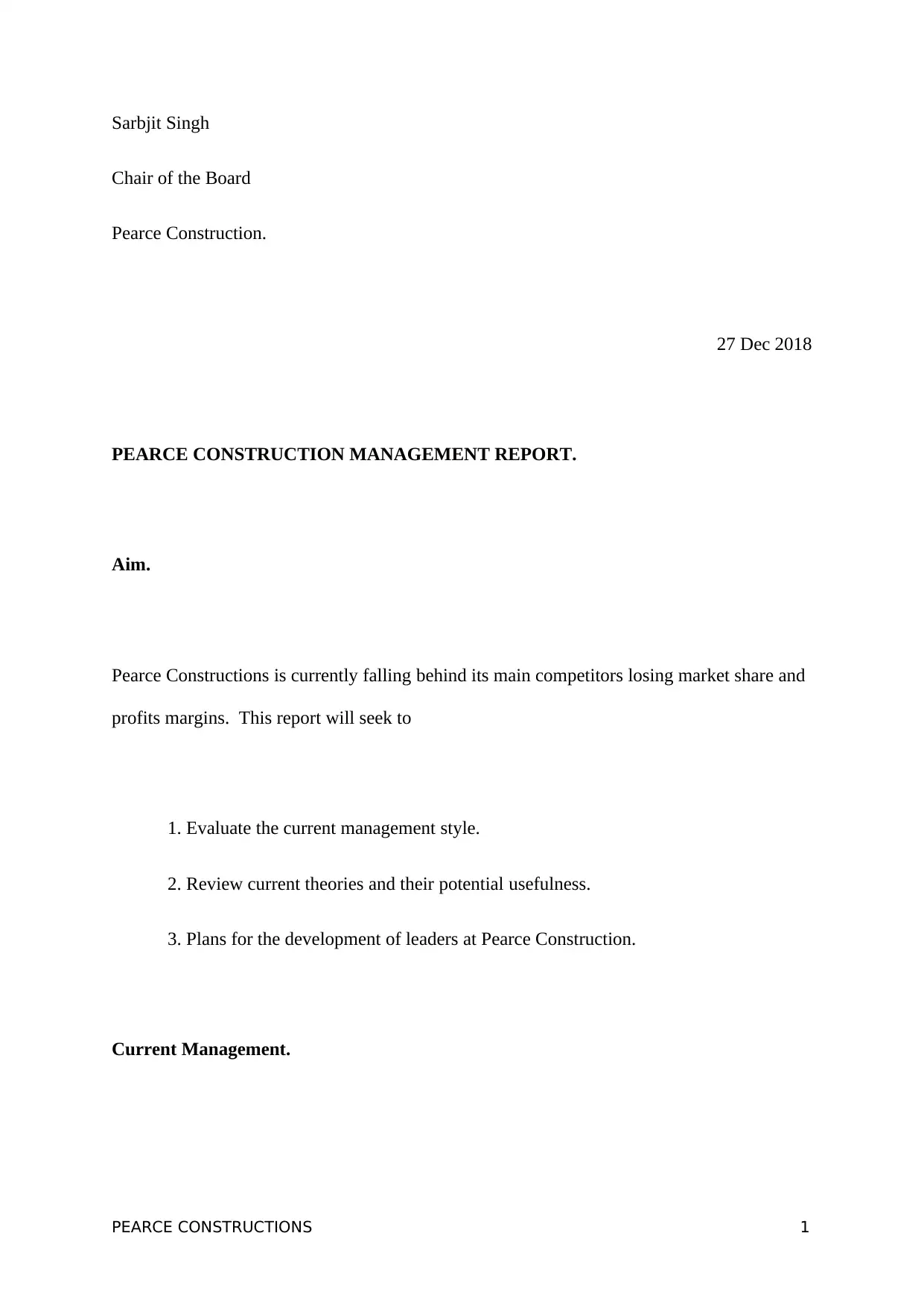
Sarbjit Singh
Chair of the Board
Pearce Construction.
27 Dec 2018
PEARCE CONSTRUCTION MANAGEMENT REPORT.
Aim.
Pearce Constructions is currently falling behind its main competitors losing market share and
profits margins. This report will seek to
1. Evaluate the current management style.
2. Review current theories and their potential usefulness.
3. Plans for the development of leaders at Pearce Construction.
Current Management.
PEARCE CONSTRUCTIONS 1
Chair of the Board
Pearce Construction.
27 Dec 2018
PEARCE CONSTRUCTION MANAGEMENT REPORT.
Aim.
Pearce Constructions is currently falling behind its main competitors losing market share and
profits margins. This report will seek to
1. Evaluate the current management style.
2. Review current theories and their potential usefulness.
3. Plans for the development of leaders at Pearce Construction.
Current Management.
PEARCE CONSTRUCTIONS 1
Paraphrase This Document
Need a fresh take? Get an instant paraphrase of this document with our AI Paraphraser
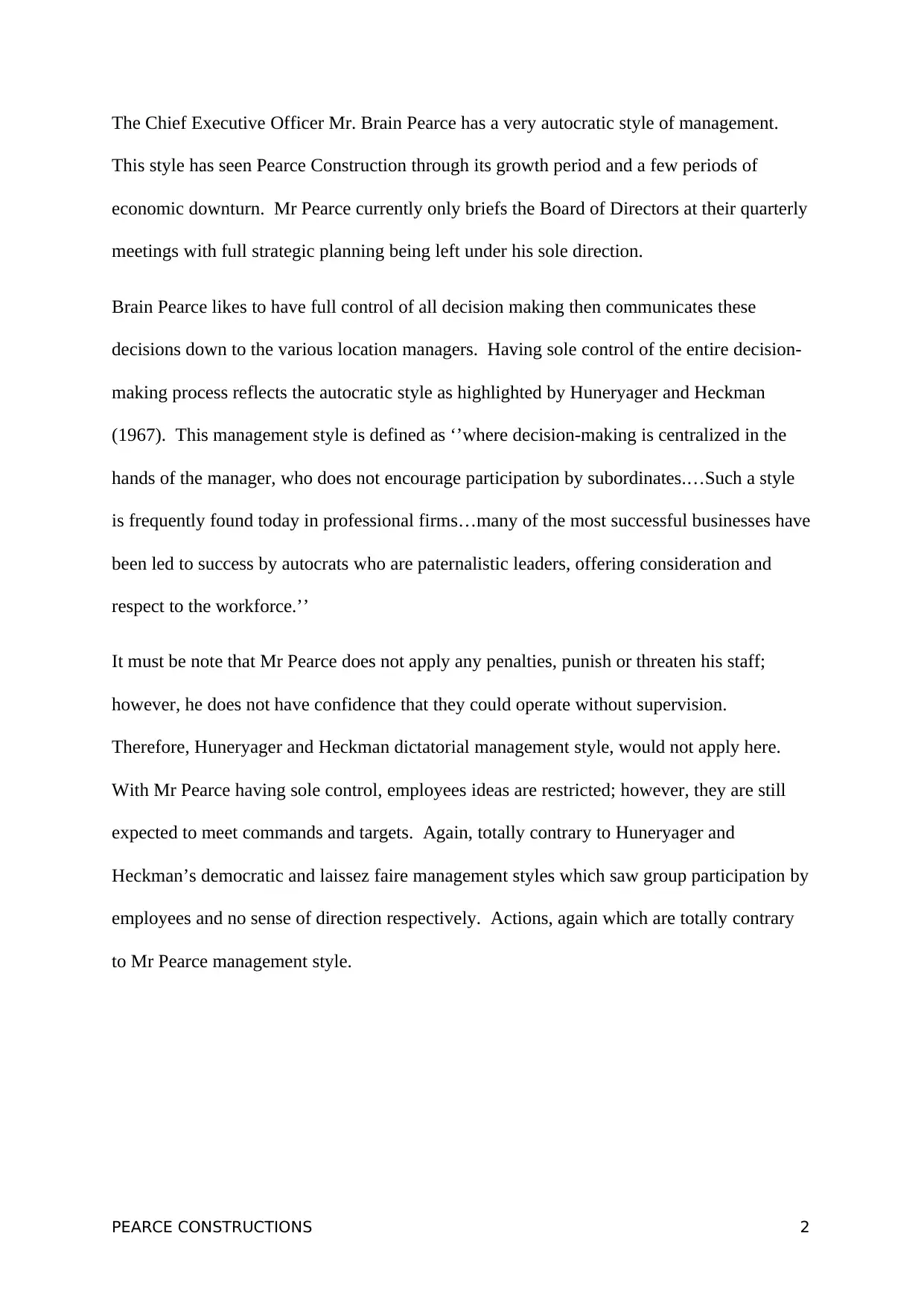
The Chief Executive Officer Mr. Brain Pearce has a very autocratic style of management.
This style has seen Pearce Construction through its growth period and a few periods of
economic downturn. Mr Pearce currently only briefs the Board of Directors at their quarterly
meetings with full strategic planning being left under his sole direction.
Brain Pearce likes to have full control of all decision making then communicates these
decisions down to the various location managers. Having sole control of the entire decision-
making process reflects the autocratic style as highlighted by Huneryager and Heckman
(1967). This management style is defined as ‘’where decision-making is centralized in the
hands of the manager, who does not encourage participation by subordinates.…Such a style
is frequently found today in professional firms…many of the most successful businesses have
been led to success by autocrats who are paternalistic leaders, offering consideration and
respect to the workforce.’’
It must be note that Mr Pearce does not apply any penalties, punish or threaten his staff;
however, he does not have confidence that they could operate without supervision.
Therefore, Huneryager and Heckman dictatorial management style, would not apply here.
With Mr Pearce having sole control, employees ideas are restricted; however, they are still
expected to meet commands and targets. Again, totally contrary to Huneryager and
Heckman’s democratic and laissez faire management styles which saw group participation by
employees and no sense of direction respectively. Actions, again which are totally contrary
to Mr Pearce management style.
PEARCE CONSTRUCTIONS 2
This style has seen Pearce Construction through its growth period and a few periods of
economic downturn. Mr Pearce currently only briefs the Board of Directors at their quarterly
meetings with full strategic planning being left under his sole direction.
Brain Pearce likes to have full control of all decision making then communicates these
decisions down to the various location managers. Having sole control of the entire decision-
making process reflects the autocratic style as highlighted by Huneryager and Heckman
(1967). This management style is defined as ‘’where decision-making is centralized in the
hands of the manager, who does not encourage participation by subordinates.…Such a style
is frequently found today in professional firms…many of the most successful businesses have
been led to success by autocrats who are paternalistic leaders, offering consideration and
respect to the workforce.’’
It must be note that Mr Pearce does not apply any penalties, punish or threaten his staff;
however, he does not have confidence that they could operate without supervision.
Therefore, Huneryager and Heckman dictatorial management style, would not apply here.
With Mr Pearce having sole control, employees ideas are restricted; however, they are still
expected to meet commands and targets. Again, totally contrary to Huneryager and
Heckman’s democratic and laissez faire management styles which saw group participation by
employees and no sense of direction respectively. Actions, again which are totally contrary
to Mr Pearce management style.
PEARCE CONSTRUCTIONS 2
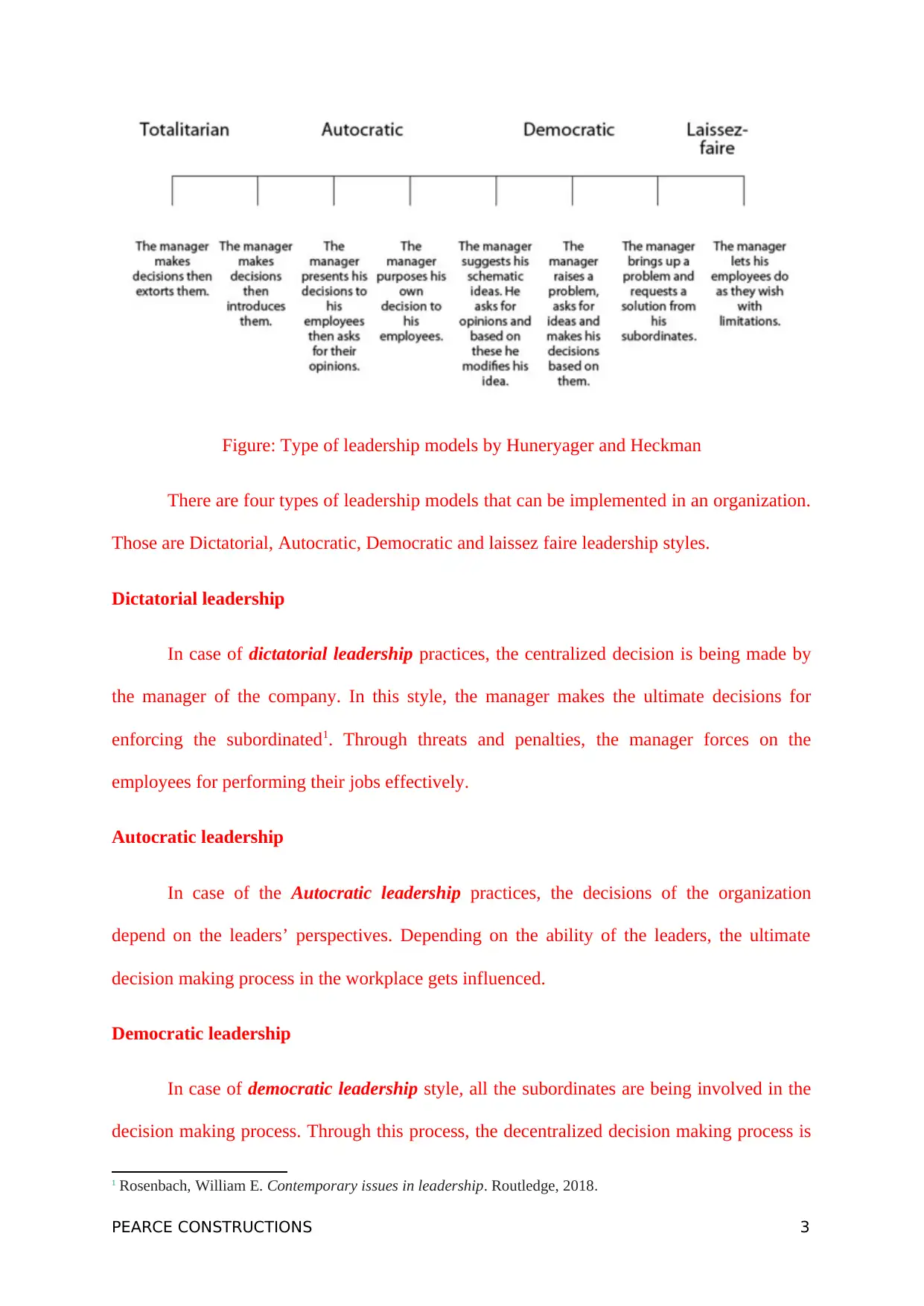
Figure: Type of leadership models by Huneryager and Heckman
There are four types of leadership models that can be implemented in an organization.
Those are Dictatorial, Autocratic, Democratic and laissez faire leadership styles.
Dictatorial leadership
In case of dictatorial leadership practices, the centralized decision is being made by
the manager of the company. In this style, the manager makes the ultimate decisions for
enforcing the subordinated1. Through threats and penalties, the manager forces on the
employees for performing their jobs effectively.
Autocratic leadership
In case of the Autocratic leadership practices, the decisions of the organization
depend on the leaders’ perspectives. Depending on the ability of the leaders, the ultimate
decision making process in the workplace gets influenced.
Democratic leadership
In case of democratic leadership style, all the subordinates are being involved in the
decision making process. Through this process, the decentralized decision making process is
1 Rosenbach, William E. Contemporary issues in leadership. Routledge, 2018.
PEARCE CONSTRUCTIONS 3
There are four types of leadership models that can be implemented in an organization.
Those are Dictatorial, Autocratic, Democratic and laissez faire leadership styles.
Dictatorial leadership
In case of dictatorial leadership practices, the centralized decision is being made by
the manager of the company. In this style, the manager makes the ultimate decisions for
enforcing the subordinated1. Through threats and penalties, the manager forces on the
employees for performing their jobs effectively.
Autocratic leadership
In case of the Autocratic leadership practices, the decisions of the organization
depend on the leaders’ perspectives. Depending on the ability of the leaders, the ultimate
decision making process in the workplace gets influenced.
Democratic leadership
In case of democratic leadership style, all the subordinates are being involved in the
decision making process. Through this process, the decentralized decision making process is
1 Rosenbach, William E. Contemporary issues in leadership. Routledge, 2018.
PEARCE CONSTRUCTIONS 3
⊘ This is a preview!⊘
Do you want full access?
Subscribe today to unlock all pages.

Trusted by 1+ million students worldwide
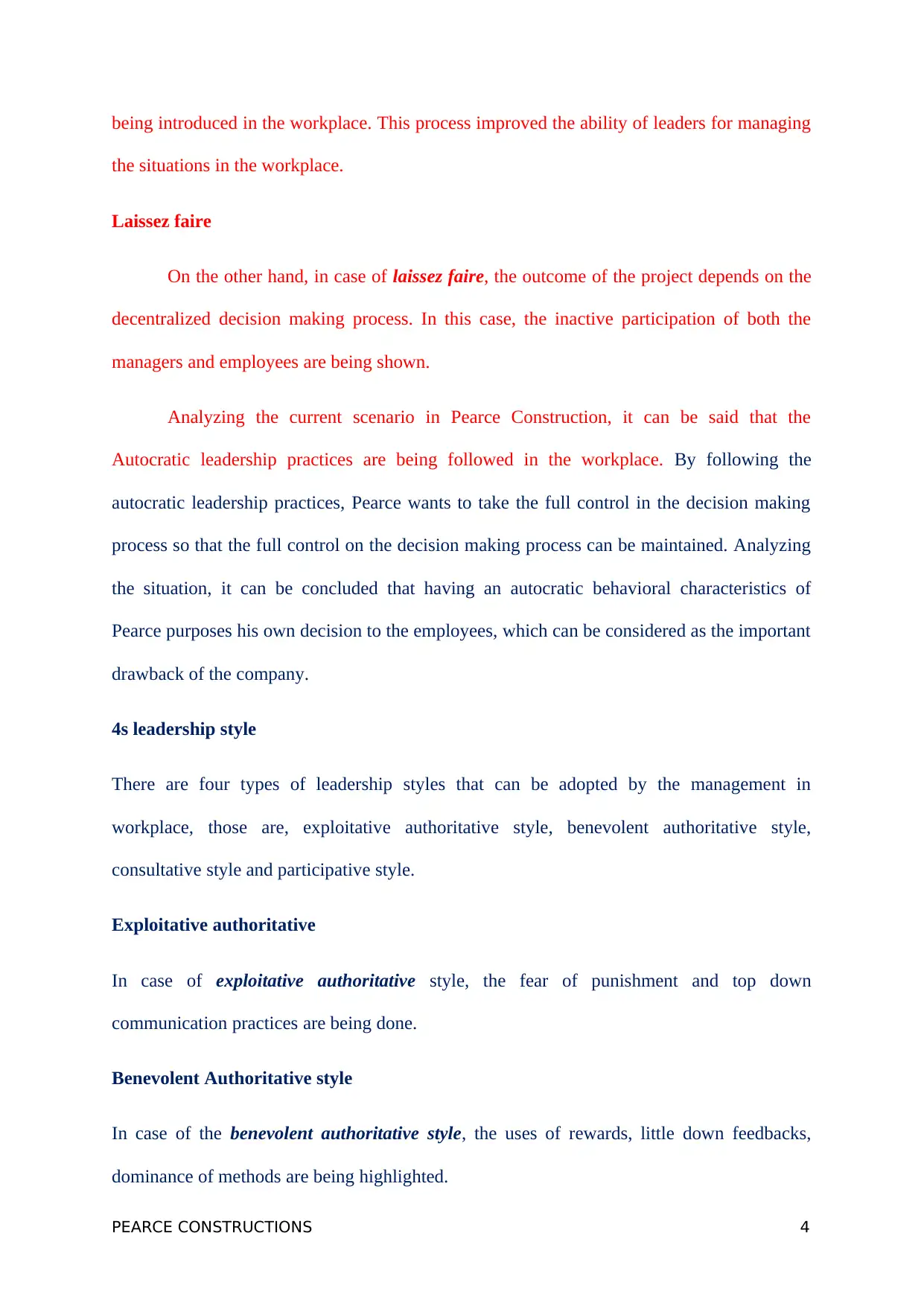
being introduced in the workplace. This process improved the ability of leaders for managing
the situations in the workplace.
Laissez faire
On the other hand, in case of laissez faire, the outcome of the project depends on the
decentralized decision making process. In this case, the inactive participation of both the
managers and employees are being shown.
Analyzing the current scenario in Pearce Construction, it can be said that the
Autocratic leadership practices are being followed in the workplace. By following the
autocratic leadership practices, Pearce wants to take the full control in the decision making
process so that the full control on the decision making process can be maintained. Analyzing
the situation, it can be concluded that having an autocratic behavioral characteristics of
Pearce purposes his own decision to the employees, which can be considered as the important
drawback of the company.
4s leadership style
There are four types of leadership styles that can be adopted by the management in
workplace, those are, exploitative authoritative style, benevolent authoritative style,
consultative style and participative style.
Exploitative authoritative
In case of exploitative authoritative style, the fear of punishment and top down
communication practices are being done.
Benevolent Authoritative style
In case of the benevolent authoritative style, the uses of rewards, little down feedbacks,
dominance of methods are being highlighted.
PEARCE CONSTRUCTIONS 4
the situations in the workplace.
Laissez faire
On the other hand, in case of laissez faire, the outcome of the project depends on the
decentralized decision making process. In this case, the inactive participation of both the
managers and employees are being shown.
Analyzing the current scenario in Pearce Construction, it can be said that the
Autocratic leadership practices are being followed in the workplace. By following the
autocratic leadership practices, Pearce wants to take the full control in the decision making
process so that the full control on the decision making process can be maintained. Analyzing
the situation, it can be concluded that having an autocratic behavioral characteristics of
Pearce purposes his own decision to the employees, which can be considered as the important
drawback of the company.
4s leadership style
There are four types of leadership styles that can be adopted by the management in
workplace, those are, exploitative authoritative style, benevolent authoritative style,
consultative style and participative style.
Exploitative authoritative
In case of exploitative authoritative style, the fear of punishment and top down
communication practices are being done.
Benevolent Authoritative style
In case of the benevolent authoritative style, the uses of rewards, little down feedbacks,
dominance of methods are being highlighted.
PEARCE CONSTRUCTIONS 4
Paraphrase This Document
Need a fresh take? Get an instant paraphrase of this document with our AI Paraphraser
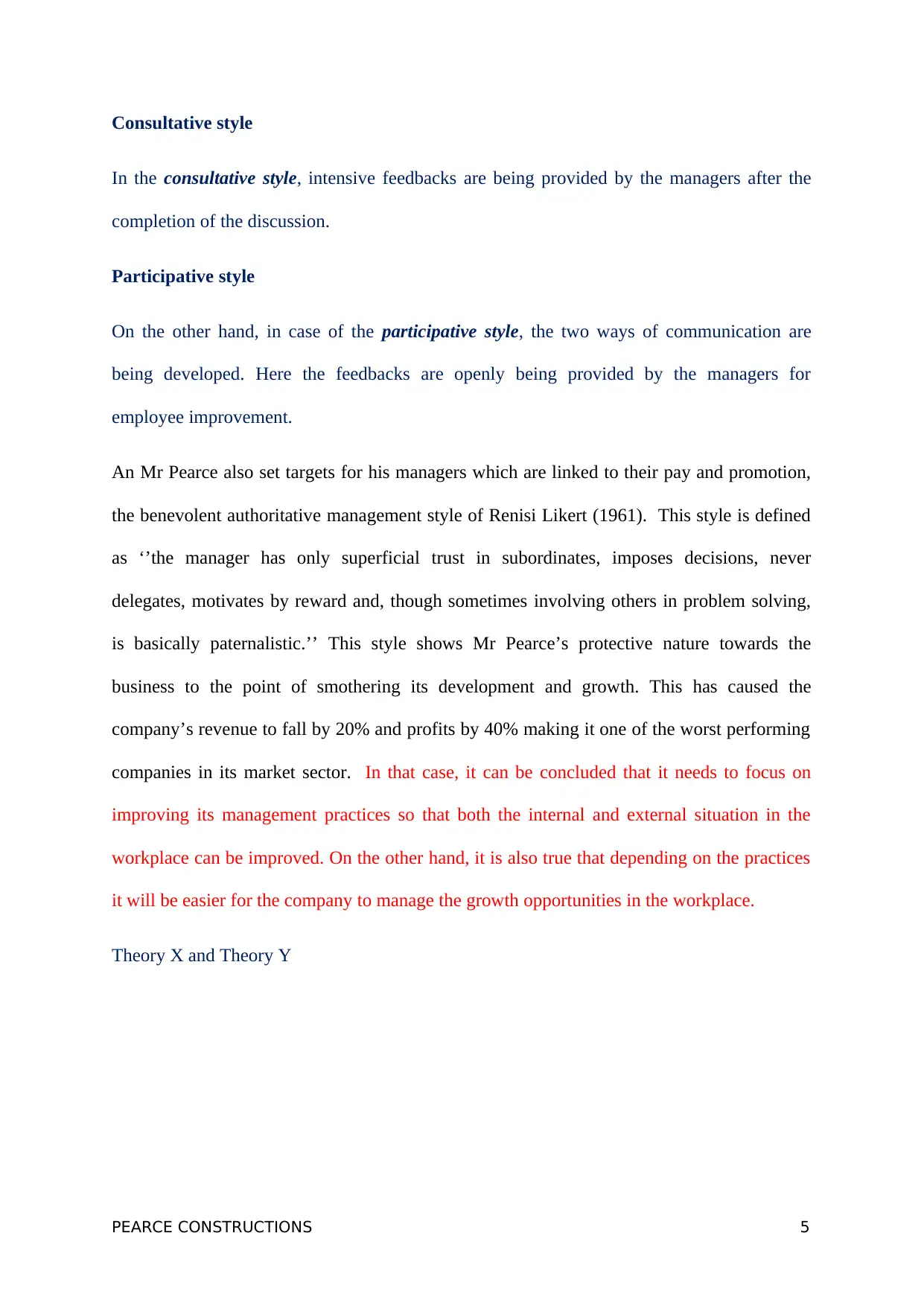
Consultative style
In the consultative style, intensive feedbacks are being provided by the managers after the
completion of the discussion.
Participative style
On the other hand, in case of the participative style, the two ways of communication are
being developed. Here the feedbacks are openly being provided by the managers for
employee improvement.
An Mr Pearce also set targets for his managers which are linked to their pay and promotion,
the benevolent authoritative management style of Renisi Likert (1961). This style is defined
as ‘’the manager has only superficial trust in subordinates, imposes decisions, never
delegates, motivates by reward and, though sometimes involving others in problem solving,
is basically paternalistic.’’ This style shows Mr Pearce’s protective nature towards the
business to the point of smothering its development and growth. This has caused the
company’s revenue to fall by 20% and profits by 40% making it one of the worst performing
companies in its market sector. In that case, it can be concluded that it needs to focus on
improving its management practices so that both the internal and external situation in the
workplace can be improved. On the other hand, it is also true that depending on the practices
it will be easier for the company to manage the growth opportunities in the workplace.
Theory X and Theory Y
PEARCE CONSTRUCTIONS 5
In the consultative style, intensive feedbacks are being provided by the managers after the
completion of the discussion.
Participative style
On the other hand, in case of the participative style, the two ways of communication are
being developed. Here the feedbacks are openly being provided by the managers for
employee improvement.
An Mr Pearce also set targets for his managers which are linked to their pay and promotion,
the benevolent authoritative management style of Renisi Likert (1961). This style is defined
as ‘’the manager has only superficial trust in subordinates, imposes decisions, never
delegates, motivates by reward and, though sometimes involving others in problem solving,
is basically paternalistic.’’ This style shows Mr Pearce’s protective nature towards the
business to the point of smothering its development and growth. This has caused the
company’s revenue to fall by 20% and profits by 40% making it one of the worst performing
companies in its market sector. In that case, it can be concluded that it needs to focus on
improving its management practices so that both the internal and external situation in the
workplace can be improved. On the other hand, it is also true that depending on the practices
it will be easier for the company to manage the growth opportunities in the workplace.
Theory X and Theory Y
PEARCE CONSTRUCTIONS 5
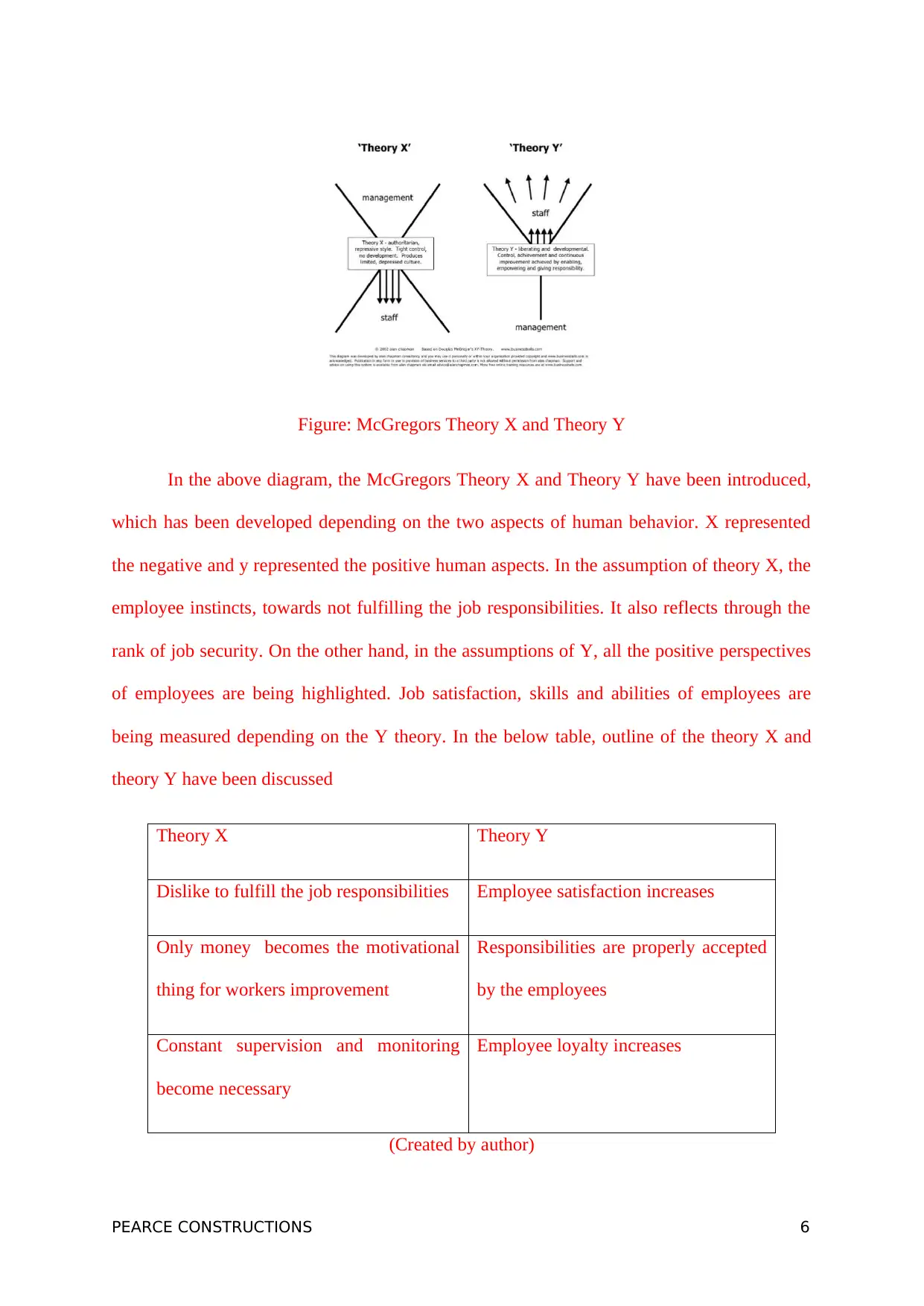
Figure: McGregors Theory X and Theory Y
In the above diagram, the McGregors Theory X and Theory Y have been introduced,
which has been developed depending on the two aspects of human behavior. X represented
the negative and y represented the positive human aspects. In the assumption of theory X, the
employee instincts, towards not fulfilling the job responsibilities. It also reflects through the
rank of job security. On the other hand, in the assumptions of Y, all the positive perspectives
of employees are being highlighted. Job satisfaction, skills and abilities of employees are
being measured depending on the Y theory. In the below table, outline of the theory X and
theory Y have been discussed
Theory X Theory Y
Dislike to fulfill the job responsibilities Employee satisfaction increases
Only money becomes the motivational
thing for workers improvement
Responsibilities are properly accepted
by the employees
Constant supervision and monitoring
become necessary
Employee loyalty increases
(Created by author)
PEARCE CONSTRUCTIONS 6
In the above diagram, the McGregors Theory X and Theory Y have been introduced,
which has been developed depending on the two aspects of human behavior. X represented
the negative and y represented the positive human aspects. In the assumption of theory X, the
employee instincts, towards not fulfilling the job responsibilities. It also reflects through the
rank of job security. On the other hand, in the assumptions of Y, all the positive perspectives
of employees are being highlighted. Job satisfaction, skills and abilities of employees are
being measured depending on the Y theory. In the below table, outline of the theory X and
theory Y have been discussed
Theory X Theory Y
Dislike to fulfill the job responsibilities Employee satisfaction increases
Only money becomes the motivational
thing for workers improvement
Responsibilities are properly accepted
by the employees
Constant supervision and monitoring
become necessary
Employee loyalty increases
(Created by author)
PEARCE CONSTRUCTIONS 6
⊘ This is a preview!⊘
Do you want full access?
Subscribe today to unlock all pages.

Trusted by 1+ million students worldwide
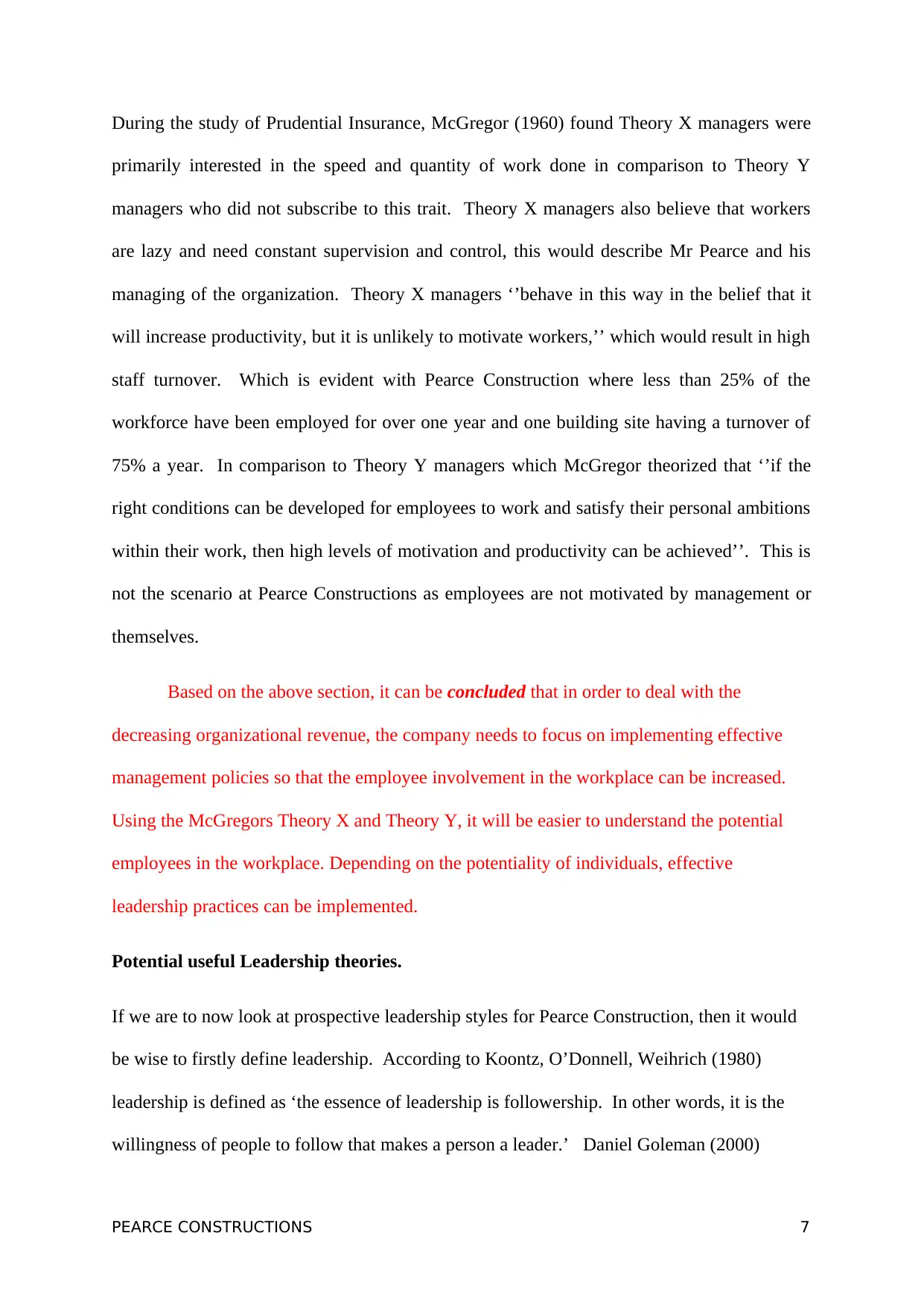
During the study of Prudential Insurance, McGregor (1960) found Theory X managers were
primarily interested in the speed and quantity of work done in comparison to Theory Y
managers who did not subscribe to this trait. Theory X managers also believe that workers
are lazy and need constant supervision and control, this would describe Mr Pearce and his
managing of the organization. Theory X managers ‘’behave in this way in the belief that it
will increase productivity, but it is unlikely to motivate workers,’’ which would result in high
staff turnover. Which is evident with Pearce Construction where less than 25% of the
workforce have been employed for over one year and one building site having a turnover of
75% a year. In comparison to Theory Y managers which McGregor theorized that ‘’if the
right conditions can be developed for employees to work and satisfy their personal ambitions
within their work, then high levels of motivation and productivity can be achieved’’. This is
not the scenario at Pearce Constructions as employees are not motivated by management or
themselves.
Based on the above section, it can be concluded that in order to deal with the
decreasing organizational revenue, the company needs to focus on implementing effective
management policies so that the employee involvement in the workplace can be increased.
Using the McGregors Theory X and Theory Y, it will be easier to understand the potential
employees in the workplace. Depending on the potentiality of individuals, effective
leadership practices can be implemented.
Potential useful Leadership theories.
If we are to now look at prospective leadership styles for Pearce Construction, then it would
be wise to firstly define leadership. According to Koontz, O’Donnell, Weihrich (1980)
leadership is defined as ‘the essence of leadership is followership. In other words, it is the
willingness of people to follow that makes a person a leader.’ Daniel Goleman (2000)
PEARCE CONSTRUCTIONS 7
primarily interested in the speed and quantity of work done in comparison to Theory Y
managers who did not subscribe to this trait. Theory X managers also believe that workers
are lazy and need constant supervision and control, this would describe Mr Pearce and his
managing of the organization. Theory X managers ‘’behave in this way in the belief that it
will increase productivity, but it is unlikely to motivate workers,’’ which would result in high
staff turnover. Which is evident with Pearce Construction where less than 25% of the
workforce have been employed for over one year and one building site having a turnover of
75% a year. In comparison to Theory Y managers which McGregor theorized that ‘’if the
right conditions can be developed for employees to work and satisfy their personal ambitions
within their work, then high levels of motivation and productivity can be achieved’’. This is
not the scenario at Pearce Constructions as employees are not motivated by management or
themselves.
Based on the above section, it can be concluded that in order to deal with the
decreasing organizational revenue, the company needs to focus on implementing effective
management policies so that the employee involvement in the workplace can be increased.
Using the McGregors Theory X and Theory Y, it will be easier to understand the potential
employees in the workplace. Depending on the potentiality of individuals, effective
leadership practices can be implemented.
Potential useful Leadership theories.
If we are to now look at prospective leadership styles for Pearce Construction, then it would
be wise to firstly define leadership. According to Koontz, O’Donnell, Weihrich (1980)
leadership is defined as ‘the essence of leadership is followership. In other words, it is the
willingness of people to follow that makes a person a leader.’ Daniel Goleman (2000)
PEARCE CONSTRUCTIONS 7
Paraphrase This Document
Need a fresh take? Get an instant paraphrase of this document with our AI Paraphraser
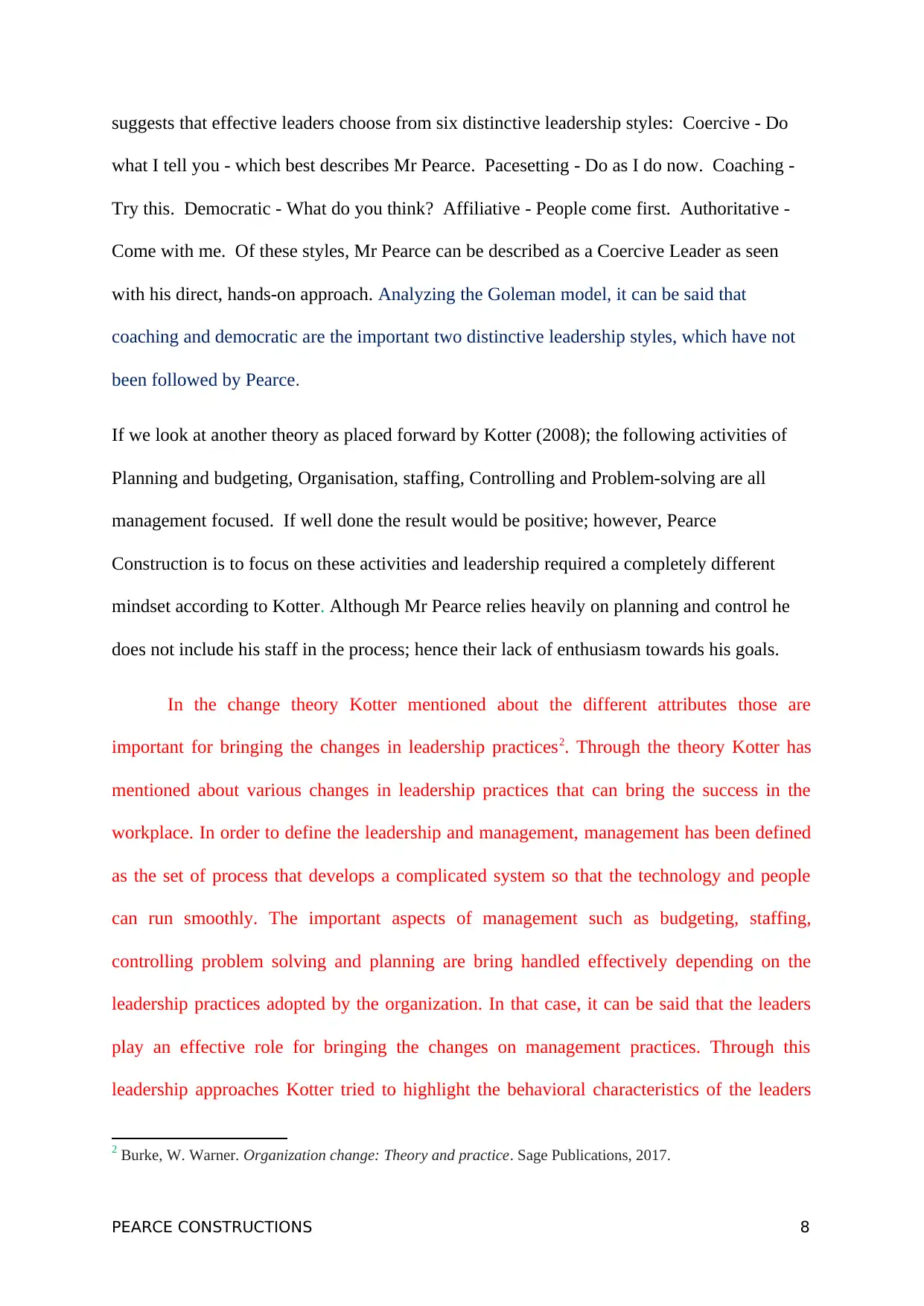
suggests that effective leaders choose from six distinctive leadership styles: Coercive - Do
what I tell you - which best describes Mr Pearce. Pacesetting - Do as I do now. Coaching -
Try this. Democratic - What do you think? Affiliative - People come first. Authoritative -
Come with me. Of these styles, Mr Pearce can be described as a Coercive Leader as seen
with his direct, hands-on approach. Analyzing the Goleman model, it can be said that
coaching and democratic are the important two distinctive leadership styles, which have not
been followed by Pearce.
If we look at another theory as placed forward by Kotter (2008); the following activities of
Planning and budgeting, Organisation, staffing, Controlling and Problem-solving are all
management focused. If well done the result would be positive; however, Pearce
Construction is to focus on these activities and leadership required a completely different
mindset according to Kotter. Although Mr Pearce relies heavily on planning and control he
does not include his staff in the process; hence their lack of enthusiasm towards his goals.
In the change theory Kotter mentioned about the different attributes those are
important for bringing the changes in leadership practices2. Through the theory Kotter has
mentioned about various changes in leadership practices that can bring the success in the
workplace. In order to define the leadership and management, management has been defined
as the set of process that develops a complicated system so that the technology and people
can run smoothly. The important aspects of management such as budgeting, staffing,
controlling problem solving and planning are bring handled effectively depending on the
leadership practices adopted by the organization. In that case, it can be said that the leaders
play an effective role for bringing the changes on management practices. Through this
leadership approaches Kotter tried to highlight the behavioral characteristics of the leaders
2 Burke, W. Warner. Organization change: Theory and practice. Sage Publications, 2017.
PEARCE CONSTRUCTIONS 8
what I tell you - which best describes Mr Pearce. Pacesetting - Do as I do now. Coaching -
Try this. Democratic - What do you think? Affiliative - People come first. Authoritative -
Come with me. Of these styles, Mr Pearce can be described as a Coercive Leader as seen
with his direct, hands-on approach. Analyzing the Goleman model, it can be said that
coaching and democratic are the important two distinctive leadership styles, which have not
been followed by Pearce.
If we look at another theory as placed forward by Kotter (2008); the following activities of
Planning and budgeting, Organisation, staffing, Controlling and Problem-solving are all
management focused. If well done the result would be positive; however, Pearce
Construction is to focus on these activities and leadership required a completely different
mindset according to Kotter. Although Mr Pearce relies heavily on planning and control he
does not include his staff in the process; hence their lack of enthusiasm towards his goals.
In the change theory Kotter mentioned about the different attributes those are
important for bringing the changes in leadership practices2. Through the theory Kotter has
mentioned about various changes in leadership practices that can bring the success in the
workplace. In order to define the leadership and management, management has been defined
as the set of process that develops a complicated system so that the technology and people
can run smoothly. The important aspects of management such as budgeting, staffing,
controlling problem solving and planning are bring handled effectively depending on the
leadership practices adopted by the organization. In that case, it can be said that the leaders
play an effective role for bringing the changes on management practices. Through this
leadership approaches Kotter tried to highlight the behavioral characteristics of the leaders
2 Burke, W. Warner. Organization change: Theory and practice. Sage Publications, 2017.
PEARCE CONSTRUCTIONS 8
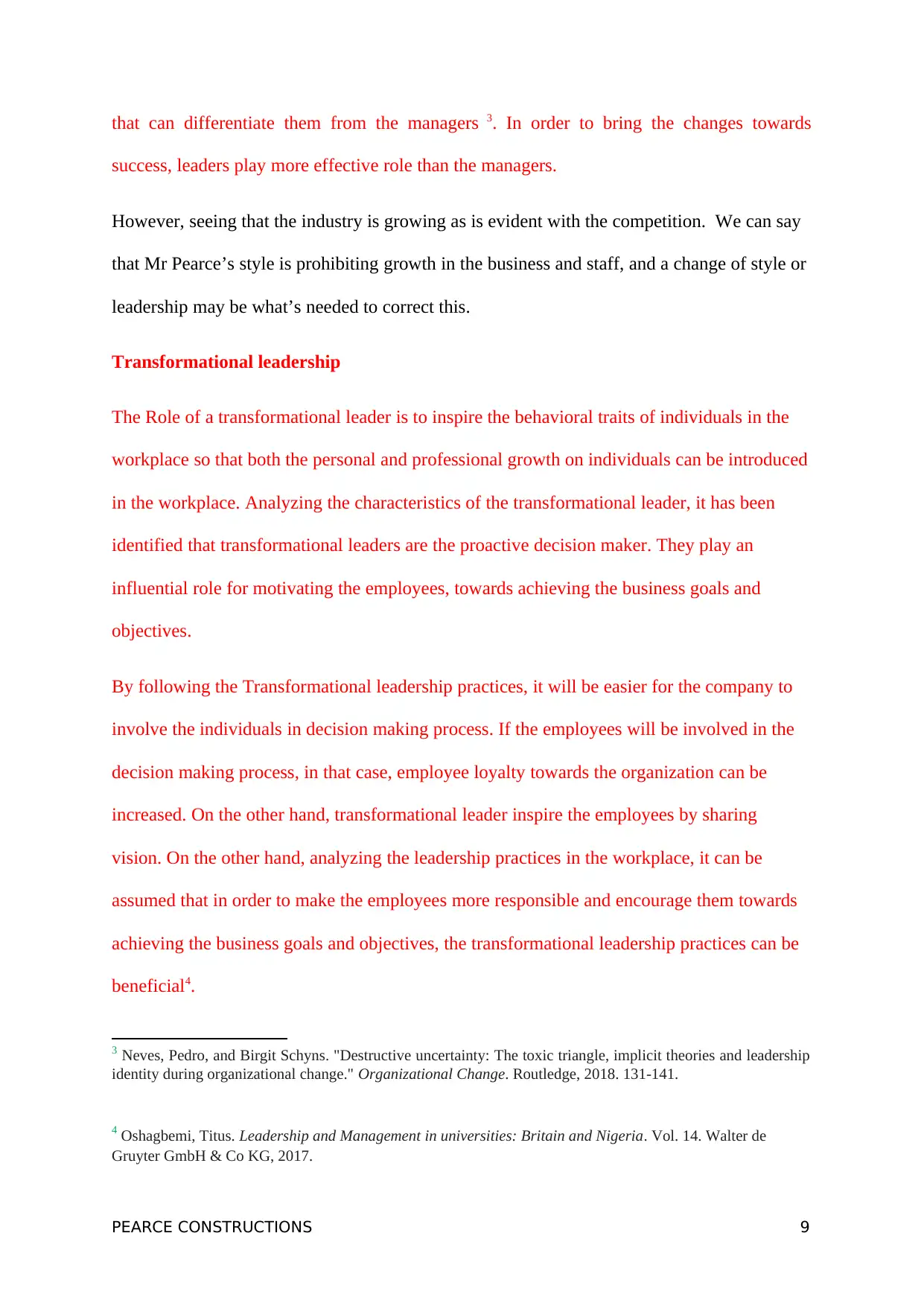
that can differentiate them from the managers 3. In order to bring the changes towards
success, leaders play more effective role than the managers.
However, seeing that the industry is growing as is evident with the competition. We can say
that Mr Pearce’s style is prohibiting growth in the business and staff, and a change of style or
leadership may be what’s needed to correct this.
Transformational leadership
The Role of a transformational leader is to inspire the behavioral traits of individuals in the
workplace so that both the personal and professional growth on individuals can be introduced
in the workplace. Analyzing the characteristics of the transformational leader, it has been
identified that transformational leaders are the proactive decision maker. They play an
influential role for motivating the employees, towards achieving the business goals and
objectives.
By following the Transformational leadership practices, it will be easier for the company to
involve the individuals in decision making process. If the employees will be involved in the
decision making process, in that case, employee loyalty towards the organization can be
increased. On the other hand, transformational leader inspire the employees by sharing
vision. On the other hand, analyzing the leadership practices in the workplace, it can be
assumed that in order to make the employees more responsible and encourage them towards
achieving the business goals and objectives, the transformational leadership practices can be
beneficial4.
3 Neves, Pedro, and Birgit Schyns. "Destructive uncertainty: The toxic triangle, implicit theories and leadership
identity during organizational change." Organizational Change. Routledge, 2018. 131-141.
4 Oshagbemi, Titus. Leadership and Management in universities: Britain and Nigeria. Vol. 14. Walter de
Gruyter GmbH & Co KG, 2017.
PEARCE CONSTRUCTIONS 9
success, leaders play more effective role than the managers.
However, seeing that the industry is growing as is evident with the competition. We can say
that Mr Pearce’s style is prohibiting growth in the business and staff, and a change of style or
leadership may be what’s needed to correct this.
Transformational leadership
The Role of a transformational leader is to inspire the behavioral traits of individuals in the
workplace so that both the personal and professional growth on individuals can be introduced
in the workplace. Analyzing the characteristics of the transformational leader, it has been
identified that transformational leaders are the proactive decision maker. They play an
influential role for motivating the employees, towards achieving the business goals and
objectives.
By following the Transformational leadership practices, it will be easier for the company to
involve the individuals in decision making process. If the employees will be involved in the
decision making process, in that case, employee loyalty towards the organization can be
increased. On the other hand, transformational leader inspire the employees by sharing
vision. On the other hand, analyzing the leadership practices in the workplace, it can be
assumed that in order to make the employees more responsible and encourage them towards
achieving the business goals and objectives, the transformational leadership practices can be
beneficial4.
3 Neves, Pedro, and Birgit Schyns. "Destructive uncertainty: The toxic triangle, implicit theories and leadership
identity during organizational change." Organizational Change. Routledge, 2018. 131-141.
4 Oshagbemi, Titus. Leadership and Management in universities: Britain and Nigeria. Vol. 14. Walter de
Gruyter GmbH & Co KG, 2017.
PEARCE CONSTRUCTIONS 9
⊘ This is a preview!⊘
Do you want full access?
Subscribe today to unlock all pages.

Trusted by 1+ million students worldwide
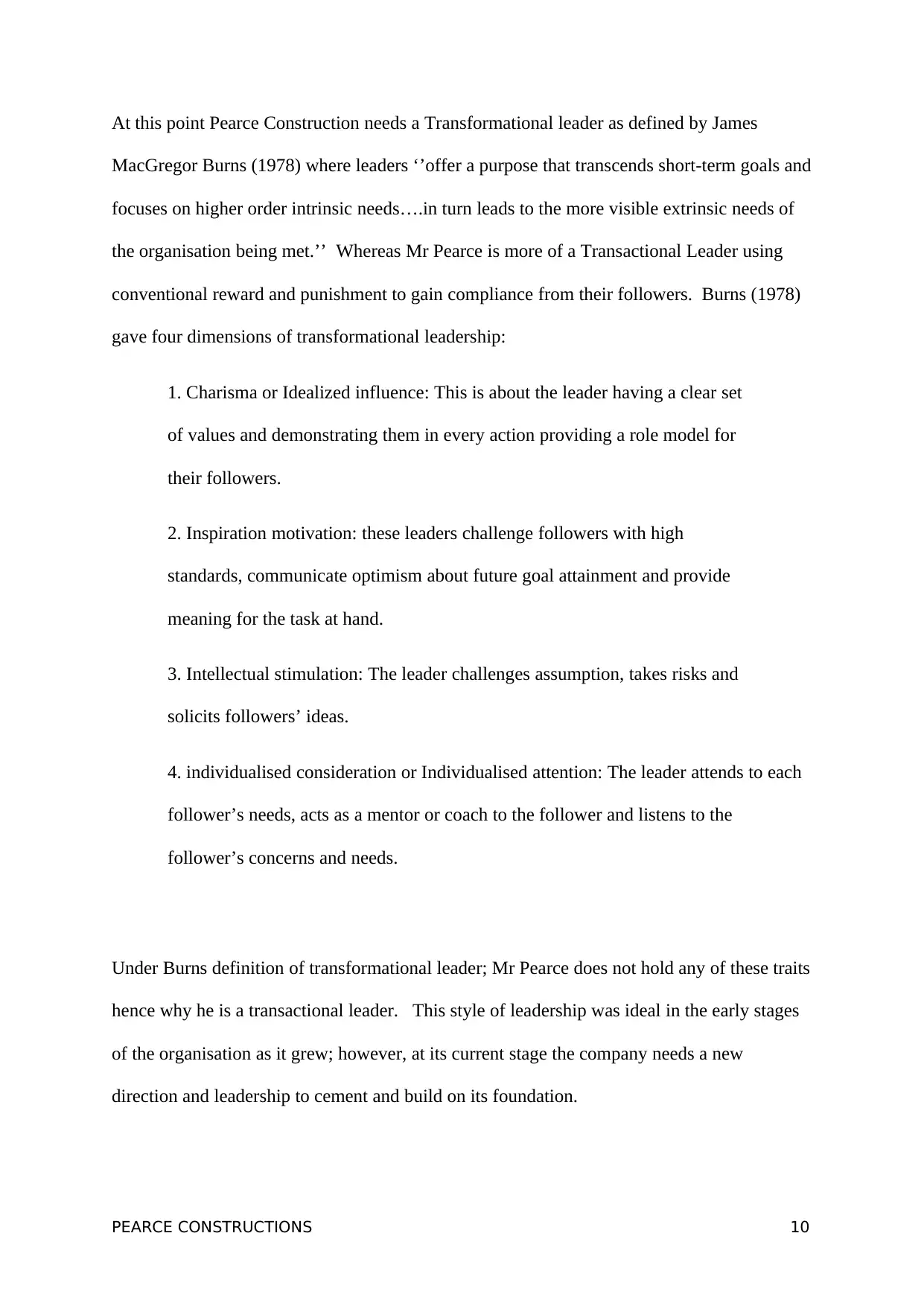
At this point Pearce Construction needs a Transformational leader as defined by James
MacGregor Burns (1978) where leaders ‘’offer a purpose that transcends short-term goals and
focuses on higher order intrinsic needs….in turn leads to the more visible extrinsic needs of
the organisation being met.’’ Whereas Mr Pearce is more of a Transactional Leader using
conventional reward and punishment to gain compliance from their followers. Burns (1978)
gave four dimensions of transformational leadership:
1. Charisma or Idealized influence: This is about the leader having a clear set
of values and demonstrating them in every action providing a role model for
their followers.
2. Inspiration motivation: these leaders challenge followers with high
standards, communicate optimism about future goal attainment and provide
meaning for the task at hand.
3. Intellectual stimulation: The leader challenges assumption, takes risks and
solicits followers’ ideas.
4. individualised consideration or Individualised attention: The leader attends to each
follower’s needs, acts as a mentor or coach to the follower and listens to the
follower’s concerns and needs.
Under Burns definition of transformational leader; Mr Pearce does not hold any of these traits
hence why he is a transactional leader. This style of leadership was ideal in the early stages
of the organisation as it grew; however, at its current stage the company needs a new
direction and leadership to cement and build on its foundation.
PEARCE CONSTRUCTIONS 10
MacGregor Burns (1978) where leaders ‘’offer a purpose that transcends short-term goals and
focuses on higher order intrinsic needs….in turn leads to the more visible extrinsic needs of
the organisation being met.’’ Whereas Mr Pearce is more of a Transactional Leader using
conventional reward and punishment to gain compliance from their followers. Burns (1978)
gave four dimensions of transformational leadership:
1. Charisma or Idealized influence: This is about the leader having a clear set
of values and demonstrating them in every action providing a role model for
their followers.
2. Inspiration motivation: these leaders challenge followers with high
standards, communicate optimism about future goal attainment and provide
meaning for the task at hand.
3. Intellectual stimulation: The leader challenges assumption, takes risks and
solicits followers’ ideas.
4. individualised consideration or Individualised attention: The leader attends to each
follower’s needs, acts as a mentor or coach to the follower and listens to the
follower’s concerns and needs.
Under Burns definition of transformational leader; Mr Pearce does not hold any of these traits
hence why he is a transactional leader. This style of leadership was ideal in the early stages
of the organisation as it grew; however, at its current stage the company needs a new
direction and leadership to cement and build on its foundation.
PEARCE CONSTRUCTIONS 10
Paraphrase This Document
Need a fresh take? Get an instant paraphrase of this document with our AI Paraphraser
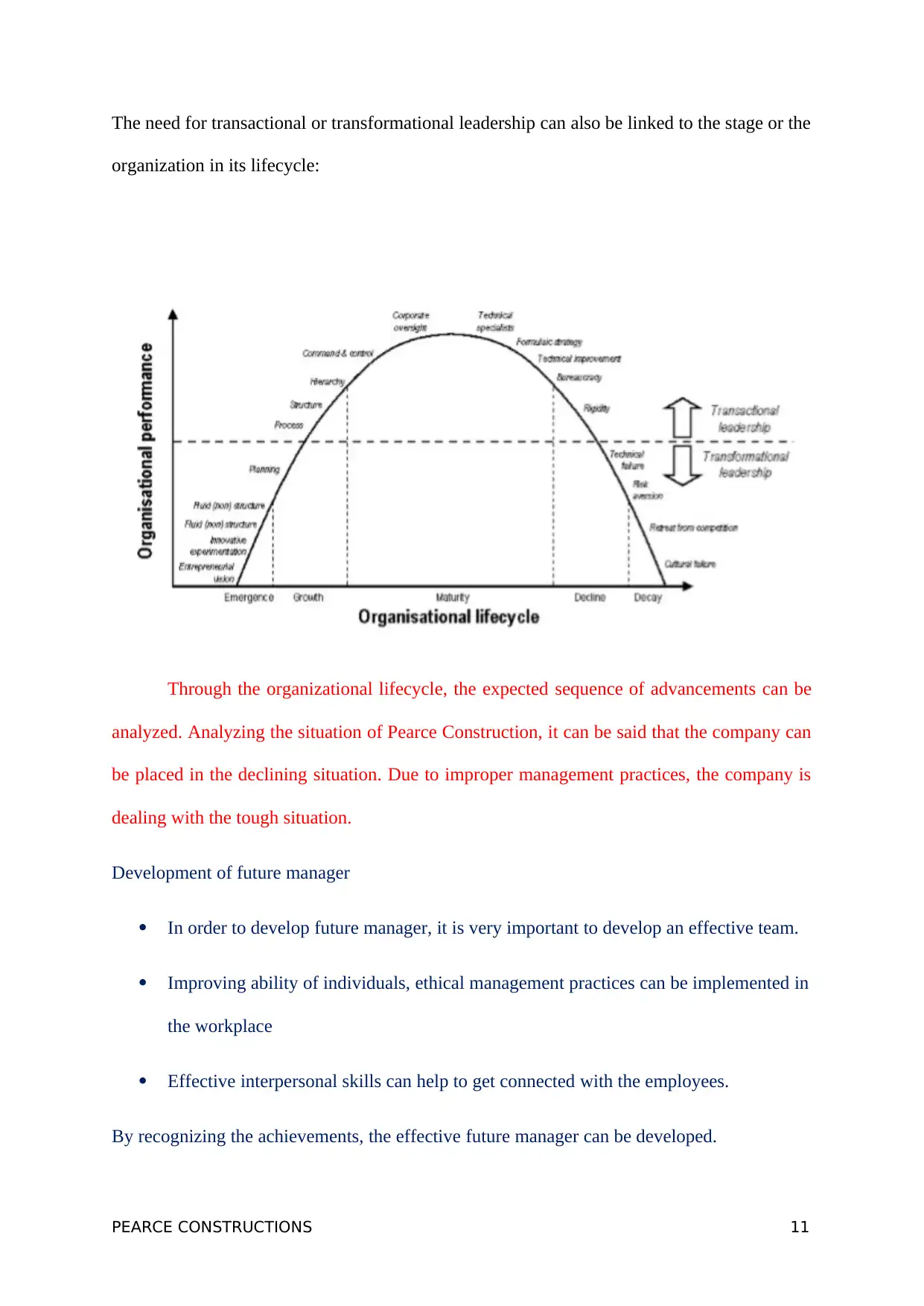
The need for transactional or transformational leadership can also be linked to the stage or the
organization in its lifecycle:
Through the organizational lifecycle, the expected sequence of advancements can be
analyzed. Analyzing the situation of Pearce Construction, it can be said that the company can
be placed in the declining situation. Due to improper management practices, the company is
dealing with the tough situation.
Development of future manager
In order to develop future manager, it is very important to develop an effective team.
Improving ability of individuals, ethical management practices can be implemented in
the workplace
Effective interpersonal skills can help to get connected with the employees.
By recognizing the achievements, the effective future manager can be developed.
PEARCE CONSTRUCTIONS 11
organization in its lifecycle:
Through the organizational lifecycle, the expected sequence of advancements can be
analyzed. Analyzing the situation of Pearce Construction, it can be said that the company can
be placed in the declining situation. Due to improper management practices, the company is
dealing with the tough situation.
Development of future manager
In order to develop future manager, it is very important to develop an effective team.
Improving ability of individuals, ethical management practices can be implemented in
the workplace
Effective interpersonal skills can help to get connected with the employees.
By recognizing the achievements, the effective future manager can be developed.
PEARCE CONSTRUCTIONS 11
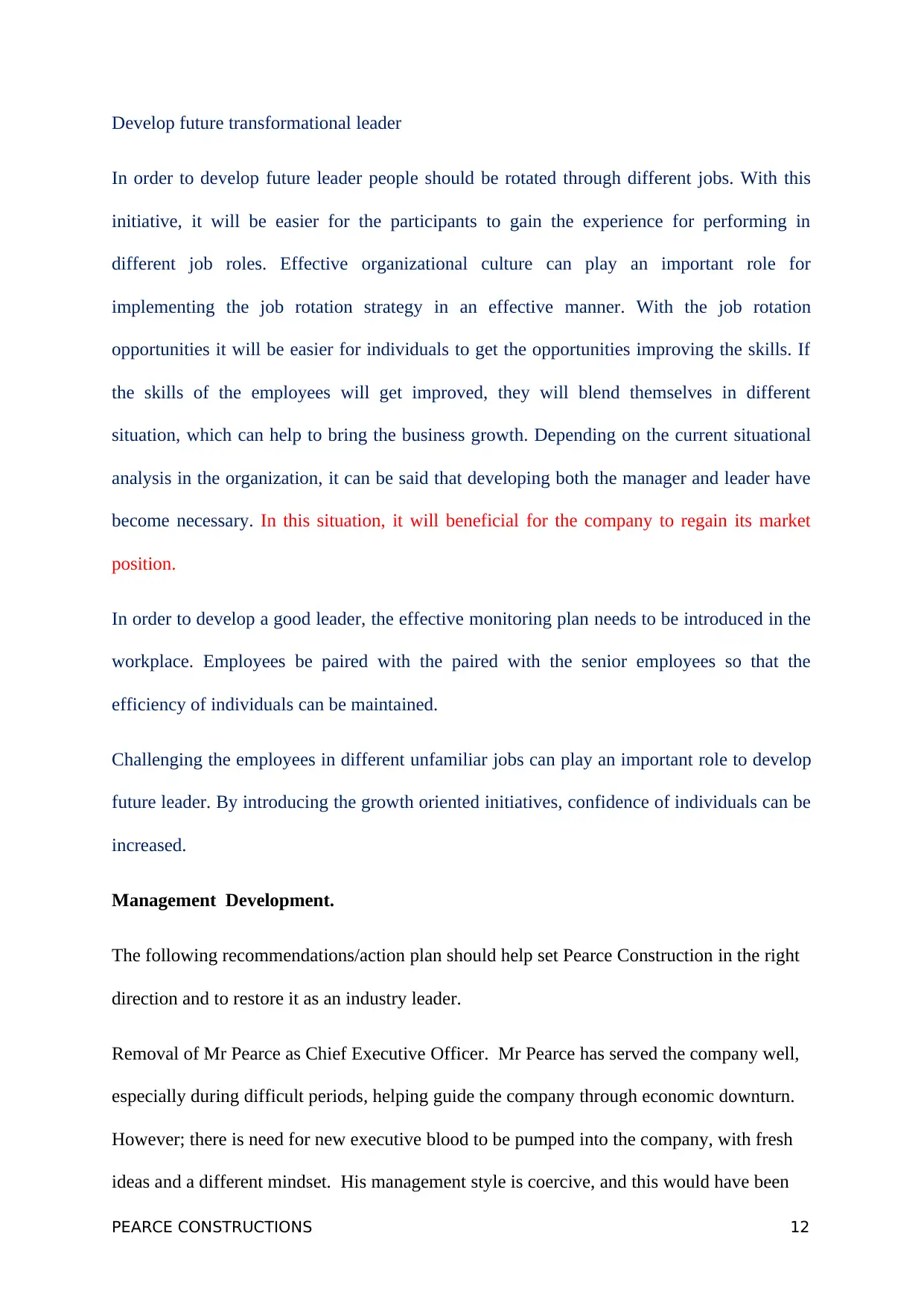
Develop future transformational leader
In order to develop future leader people should be rotated through different jobs. With this
initiative, it will be easier for the participants to gain the experience for performing in
different job roles. Effective organizational culture can play an important role for
implementing the job rotation strategy in an effective manner. With the job rotation
opportunities it will be easier for individuals to get the opportunities improving the skills. If
the skills of the employees will get improved, they will blend themselves in different
situation, which can help to bring the business growth. Depending on the current situational
analysis in the organization, it can be said that developing both the manager and leader have
become necessary. In this situation, it will beneficial for the company to regain its market
position.
In order to develop a good leader, the effective monitoring plan needs to be introduced in the
workplace. Employees be paired with the paired with the senior employees so that the
efficiency of individuals can be maintained.
Challenging the employees in different unfamiliar jobs can play an important role to develop
future leader. By introducing the growth oriented initiatives, confidence of individuals can be
increased.
Management Development.
The following recommendations/action plan should help set Pearce Construction in the right
direction and to restore it as an industry leader.
Removal of Mr Pearce as Chief Executive Officer. Mr Pearce has served the company well,
especially during difficult periods, helping guide the company through economic downturn.
However; there is need for new executive blood to be pumped into the company, with fresh
ideas and a different mindset. His management style is coercive, and this would have been
PEARCE CONSTRUCTIONS 12
In order to develop future leader people should be rotated through different jobs. With this
initiative, it will be easier for the participants to gain the experience for performing in
different job roles. Effective organizational culture can play an important role for
implementing the job rotation strategy in an effective manner. With the job rotation
opportunities it will be easier for individuals to get the opportunities improving the skills. If
the skills of the employees will get improved, they will blend themselves in different
situation, which can help to bring the business growth. Depending on the current situational
analysis in the organization, it can be said that developing both the manager and leader have
become necessary. In this situation, it will beneficial for the company to regain its market
position.
In order to develop a good leader, the effective monitoring plan needs to be introduced in the
workplace. Employees be paired with the paired with the senior employees so that the
efficiency of individuals can be maintained.
Challenging the employees in different unfamiliar jobs can play an important role to develop
future leader. By introducing the growth oriented initiatives, confidence of individuals can be
increased.
Management Development.
The following recommendations/action plan should help set Pearce Construction in the right
direction and to restore it as an industry leader.
Removal of Mr Pearce as Chief Executive Officer. Mr Pearce has served the company well,
especially during difficult periods, helping guide the company through economic downturn.
However; there is need for new executive blood to be pumped into the company, with fresh
ideas and a different mindset. His management style is coercive, and this would have been
PEARCE CONSTRUCTIONS 12
⊘ This is a preview!⊘
Do you want full access?
Subscribe today to unlock all pages.

Trusted by 1+ million students worldwide
1 out of 21
Related Documents
Your All-in-One AI-Powered Toolkit for Academic Success.
+13062052269
info@desklib.com
Available 24*7 on WhatsApp / Email
![[object Object]](/_next/static/media/star-bottom.7253800d.svg)
Unlock your academic potential
Copyright © 2020–2025 A2Z Services. All Rights Reserved. Developed and managed by ZUCOL.





